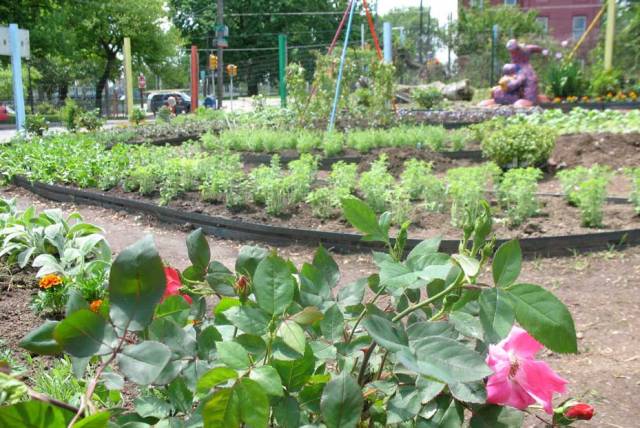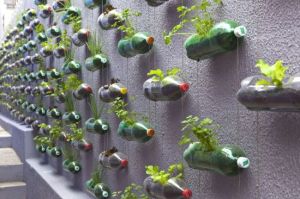
Anyone who gets organic garden magazines has been subjected to the “garden porn” of California raised beds overflowing with herbs and vegetables and other gardens at their peak. The false sense they convey is that if everyone did this, we could all feed ourselves off the land!
In recent years, I’ve read a lot of articles about urban gardening, encouraging even apartment dwellers to grow mini vertical gardens up their windows in empty 2-liter coke bottles, or to grow food on their postage-stamp patios. The photos are gorgeous, but they also convey this false promise of lots of beautiful, fresh food.
These days, urban gardening and the idea that we can have “sustainable” local food sources in cities has become a buzz word for attracting grants and political support. Seattle has designed a food forest that people will be able to forage in for free blueberries and fruit. Ah, the vision of neighborhood children on an annual blueberry picking trip, just like Sal, but without the bears. The article notes that they haven’t decided what to do to keep people from over-harvesting and not leaving fruit for their neighbors’ children. In this utopian vision, everyone will share and no one will be greedy. And… there will be plenty for all!
I am a fan of this utopian vision, of course. Who could be opposed? I do believe it is very good for fighting climate change to increase green space in cities, and that includes green space on rooftop gardens. Chicago has been a leader in this area. I also think it’s very good for people to see real food and how it grows. It is good for children to know about plants and about pests and to eat a tomato or salad that they grew from seed. I remember as a kid all those experiments with potatoes stuck with toothpicks sprouting on windowsills. It was cool that the potato “grew,” but having never put one of them in the ground and seen the leaves and the ultimate score of potatoes at harvest, it was pretty abstract. Mostly I remember it as kind of gross by the end, a slimy mess we threw away.
I think having community gardens is fantastic. I especially think it’s great when people from other cultures can introduce their native foods to an area– I’m thinking specifically of my Argentinian friend’s zapallitos and the prolific Chicago tomatillos and Hmong long beans in Minneapolis. I’m also thinking of the glories of Long Beach, California, neighborhoods, where there were plenty of lemons for people to forage and rosemary hedges. An apartment building on my block had gorgeous “edible” landscaping in front of it. I often took herbs from there– but I did not take cabbage or kale! Because, of course, there was only one beautiful head per plant to be had, and it did not belong to me.
I think edible landscaping is also great, especially if you can convince the neighbors to put up with the “messiness” of them, the fact that for most of the year they are “dormant” and unproductive, not full of green and flowers and fruit. Planting fruit trees is wonderful, especially for preserving our pollinators. However, you need the resources to prune them and protect them from deer. Berry bushes can get invasive and people have to be willing to put up with the berry-laden poop of birds and tracking berries through the sidewalks and into homes. Most people I know with berry bushes have tried to get rid of them. Again, too messy. If we can change people’s focus from the mess to the resource, i.e., get them to make jam instead, that will be great.
At the end of the day, I don’t think all this fervor for urban gardening adds up to much more than an educational endeavor. It is clearly not going to replace industrial agriculture. As a recent article in the New York Observer argues, it’s not just about economics but also about what we mean by “green” that dooms locavore agriculture schemes. You can’t transport the locally grown food without using a lot of energy.
I love this direction our society is taking, obviously. I also see it as having three basic parts:
1) rejuvenation of the small farm industry: lots of young people are actually going into farming in rural areas, taking over small plots of land and making a go of it growing food and distributing it through local channels. CSAs and farmer’s markets are bringing good food to a lot of people and connecting them more closely to the production of food.
2) social justice initiatives: community gardens and food initiatives in urban areas are providing community building and healthy opportunities for immigrants, school children and others to connect. Urban planners are thinking about ways to make cities more green as a way to slow global climate change. People are learning about healthy food and having a chance to see how produce grows and grow their own crops. I am always reminded of my former husband coming home from volunteer clean-up work at the Robert Taylor Homes in Chicago with a large amount of basil that was growing wild along a chain link fence. It was abandoned, but had at one point been someone’s connection to fresh food in the bleakest of environments.
3) elite access to quality food: It is still the elite who have access to most of this good food. Those locavore restaurants where farms provide (a few!!) ingredients are expensive! So are the twelve varieties of micro-greens at the Union Square farmer’s market in New York. And it is not lost on me that our fantastic experience shopping with Marjorie in NYC a few years ago included the farmer’s market and also some of the finest imported cheese, meats, and nuts/spices from Italy and the Middle East, a culinary adventure you’d have difficulty replicating anywhere but New York City– or accomplishing in a single day without a car in New York City.
It is from this privileged place that I am experiencing the food movement. I’m so happy about it, but I’m not kidding myself. Every time I think about a way to turn this into a money-making enterprise, I quickly give up. The best bet would be to find a niche and really exploit it. The best business model in this area is Forest Mushrooms, whose inventory is only partially locally grown. The local artisan baker does very well, too, but only because there are people willing to pay $5-7 for a quality loaf of bread.
When I see the stories and the wild promises of feeding neighborhoods, I’m almost always swept away. Then I have to regather myself and realize that it takes so much time and space and energy just to grow a little bit of food! I remember how fast my leeks disappear, and my garlic, and even my rows of onions.
This time of year, our larder is more bare. We ate the last butternut squash yesterday, roasted with some of the last potatoes, a few last turnips, and some Forest mushrooms, store-bought carrots, onions and garlic. Brussels sprouts are up to $6/lb, so we’ve mostly been eating the price-stabilized broccoli and romaine lettuce, which come on big trucks or train cars from California or Mexico I’m sure.





I think it’s important to distinguish urban farming from cutesy projects like that utterly impractical soda bottle wall. Seriously? I’d have to water that at least 3 times a day here.
I am delighted to live in an era where global transportation of food is possible, virtually eliminating the period of starvation and death following large regional crop failures. But I also think it’s important not to ignore the huge areas of urban land that are horticultural desert. Sure, it takes energy to transport local food, but not as it does much to fly in bananas from Costa Rica.
Everyone tends to ignore the other major successful urban food projects of the past — Detroit in 1893, Liberty Gardens of WWI, Depression Relief Gardens and more — in favor of the Victory Gardens of WWII. But even if we look at that one era, 44% of the fresh vegetables consumed in the US during the war were produced in backyards, abandoned lots and on public property.
While we can’t feed America by ripping up lawns, urban farming and gardening can definitely make a huge dent.
Thank you, Nicole, for this thoughtful comment. I agree that I’m painting with a broad brush and putting together a wide range of things. I also acknowledge that the recent stuff that has been getting to me are unrealistic items that seem to fill my Facebook feed. One thing I have learned about eating from the garden is that you have to really simplify. You aren’t going to have tons of exotic ingredients coming from the garden. You’re also going to eat different things once you freeze and can stuff. I do applaud the social justice efforts that provide gardening space to people in blighted areas and/or food deserts. There is no doubt a lot of good out there.
I share your eye-rolling and occasional teeth grinding at the craft and art project gardening memes and “One weird trick to a pest-free garden!” headlines. A tomato plant in a pot is a gateway drug, but high maintenance schemes and unrealistic goals sends people running back to the grocery store in frustration.
I love your realistic take on all this, and I’ve often wondered about the promises of feeding large numbers of people with urban gardens and permaculture schemes. I also share your excitement about the positive aspect of all this — especially getting people into contact with growing things outdoors.
Growing my own garden (up here in Duluth MN) has taught me many things, but most importantly two. First, I’ve learned a lot about the “patient way,” that is, working on something slowly, day by day, without a guaranteed outcome. Second, I’ve learned how difficult it can be to grow food when nature does not cooperate — something that nature seems less and less inclined to do (thanks to us humans, perhaps). In other words, food is sacred, and a blessing, and not something to be taken for granted, as there may come a time when it becomes very hard to grow at all.
Thank you for the comment, Ruth! It is always a miracle to me that any food can be grown at all, but then I expect my garden to be my grocery store and it doesn’t work that way! Vegetable gardening is definitely a “patient way” and countercultural still– but I am hopeful that we can see beyond gimmicks and walk more and more in that way…